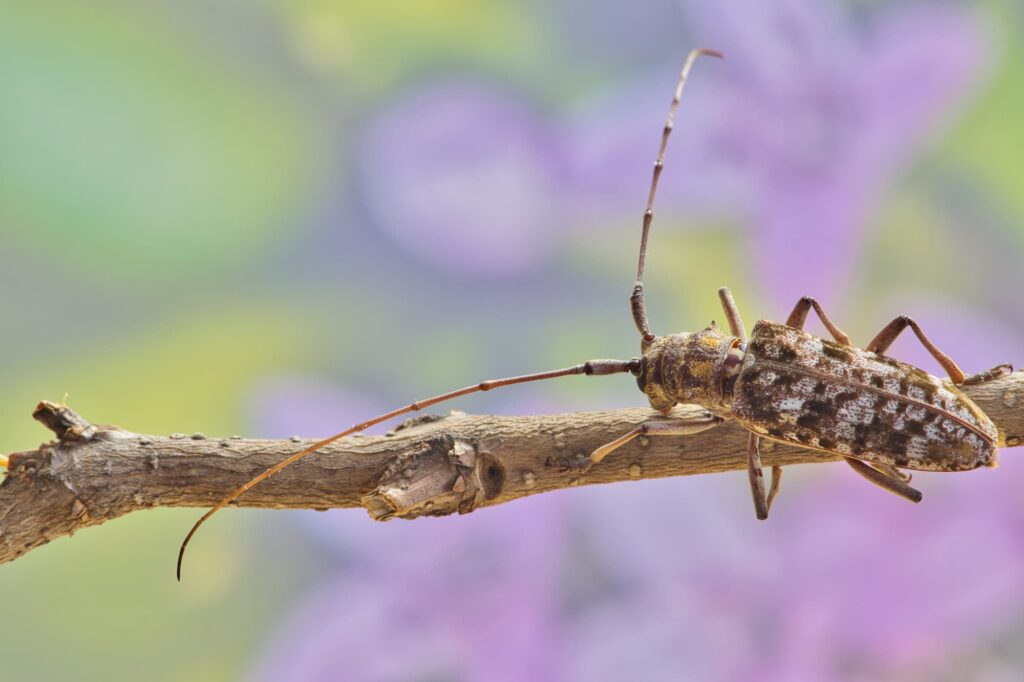Sap–Eating Bore Beetle feed upon the roots and branches, these are some of the most damaging insects to your trees.
What Are Bore Beetles?
Wood-boring beetles, also known as woodworms, are a type of insect that feeds on and burrows through wood. There are many different species of wood-boring beetles, each with its own unique characteristics and behaviors. These insects can be found in various types of wood, including trees, lumber, furniture, and even houses.
Bore Beetle Life Cycle
The life cycle of a wood-boring beetle begins when the adult female lays her eggs on or near a source of wood. The eggs hatch into larvae, which are small, white, and worm-like in appearance. The larvae burrow into the wood and begin feeding, creating tunnels and galleries as they go. The larvae can stay in the wood for several years, feeding and growing until they are ready to pupate.
Once the larvae are fully grown, they pupate and emerge as adult beetles. The adult beetles mate and the females lay more eggs, starting the cycle over again. Some species of wood-boring beetles have one generation per year, while others may have several.
Most Commonly Known Beetles
1. Termites
One of the most well-known and destructive species of wood-boring beetles is the termite. Termites are social insects that live in colonies and are known for their ability to cause significant damage to wood structures. However, there are many other species of wood-boring beetles that can also cause damage, including the powderpost beetle, the old house borer, and the Asian long-horned beetle.
2. Powderpost Beetles
Powderpost beetles are small, reddish-brown insects that are named for the fine, powdery residue they leave behind as they bore through wood. They are often found in hardwoods, such as oak and ash, and can cause significant damage to furniture, flooring, and other wood structures.
3. Old House Borers
Old house borers are larger insects that are native to North America. They are named for their tendency to attack older houses, but they can also be found in new construction. Old house borers are most commonly found in softwoods, such as pine and cedar, and can cause significant damage to both structural and decorative wood elements.
4. Asian Long-Horned Beetles
Asian long-horned beetles are a non-native species that have been introduced to North America and Europe. They are large, black beetles with white spots and long antennae. These beetles are known for their ability to attack and kill a wide range of trees, including maple, elm, and willow.
5. Wood-Boring Beetles
Wood-boring beetles can cause significant damage to wood structures, and their presence can greatly reduce the value and stability of these structures. It is important to identify and address infestations as soon as possible to prevent further damage.
Prevention and Treatment
There are several methods for controlling wood-boring bore beetles, including chemical treatments, heat treatments, and physical removal. Chemical treatments involve the use of insecticides to kill the beetles and their larvae. Heat treatments involve using high temperatures to kill the insects, and can be effective for smaller infestations. Physical removal involves removing and replacing infested wood, which is often necessary for more severe infestations.
Preventing wood-boring beetle infestations is the best way to protect your wood structures. Some steps you can take to prevent infestations include using treated wood for construction, sealing cracks and crevices, and storing wood away from your home. Regular inspections can also help you identify and address any infestations before they become severe.
Conclusion
In conclusion, wood-boring bore beetles are a type of insect that feeds on and burrows through wood. There are many different species of wood-boring beetles, each with its own unique characteristics and behaviors. These insects can cause significant damage to wood structures and their presence can greatly reduce the value and stability of these structures. Are you looking for another Tree Insect?
Want To Talk To A Certified Arborist?
Do you have more questions about your oak tree? Do you have oak wilt on the trees on your property? Do you have Tree Disease on your property in Texas? Call us today at (817) 799-7808 to talk to our Tree Care Experts.
North Texas Tree Care
As a North Texas-based tree care company, Oakwilt.org does more than just provide industry-leading tree care, we’re here to serve our beloved community. By giving our North Texas trees proper care and maintenance through routine tree check-ups and treating them for oak wilt when necessary, we can promote a greener, more sustainable North Texas community. For help with tree disease treatment and tree nutrition, tree care and tree insect management, soil conditioning, and more, contact our ISA Certified Arborists to get started.
Oakwilt.org is a full-service sustainable tree care company offering residential and commercial tree services and tree disease treatment and management in Dallas, Waco, Austin, Fort Worth, San Marcos, San Antonio, DFW, and more. Contact our North Texas tree care experts at (817) 799-7808 and enjoy 5-star rated tree care customer service and the best tree health services in North Texas!
To learn more about North Texas Tree Insects: Fall Webworms, Oak Leaf Rollers, and Sap-Eating Bore Beetles, call our North Texas team of Arborist
at (817) 799-7808 or fill out the contact form.
We’re a little different than the average tree care company.
Learn more about Oakwilt.org ISA Certified Arborists!
Our North Texas-based tree doctors can explain how sustainable tree care services add more value to your properties.
Find out more today by giving us a call today.

